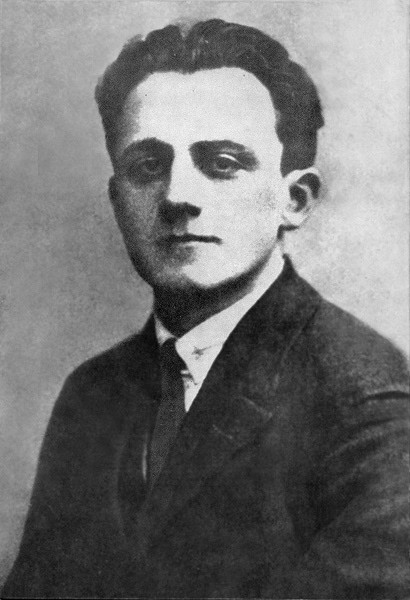- News
- Events
- Oneg Shabbat
- Collections
- Research
- Exhibitions
- Education
- Publishing Department
- Genealogy
- About the Institute
- Bookstore

7 March 2018 marks the 74th anniversary of discovering the „Krysia” bunker by the Germans. In the bunker, located in the Ochota district of Warsaw, 38 Jews had remained in hiding for several months, among them Emanuel Ringelblum, his wife Judyta and son Uri.
The bunker was located under Mieczysław Wolski’s greenhouse at 81 Grójecka street. It was probably the biggest hideaway for the Jews after the liquidation of the Warsaw ghetto. The Wolski family had been hiding Jews since 1942, and in the bunker itself – since March 1943. Ringelblum and his family found their hideaway there in Spring that year. Since then, Ringelblum would leave the bunker only alone and go to the ghetto. During one of such visits, he was arrested and transported to a camp in Trawniki. Thanks to help from the Żegota organisation, he managed to escape in August. After coming back to Warsaw, he returned to the bunker at Grójecka, where he spent the next following months.
- The living conditions at the bunker were decent. People who stayed there had access to water, bathrooms, electricity. During his stay there, Ringelblum remained very active – he wrote an essay in Polish, ’ Polish-Jewish relations during the Second World War’, he also exchanged letters with Adolf Berman, the secretary of Żegota. The location of the bunker was very convenient; Warsaw practically ended nearby. Regular buildings reached the Narutowicz Square, beyond which stretched suburban greenhouses and farms. The rotation of hiding people was small, so they could hope for survival, says professor Andrzej Żbikowski.

Providing hideaways for the Jews – although not on such a large scale as in „Krysia” — wasn’t uncommon in the wartime Warsaw. In late 1943, after the liquidation of the ghetto, about 20,000 Jewish citizens remained in hiding in the city, and before the beginning of the Warsaw Uprising – even 27,000, including about 4,000 assimilated citizens who didn’t identify as Jews and about 4,000 Jews from beyond Warsaw, who could find safety in the city.
Wolski’s bunker was eventually exposed on 7 March 1944. The circumstances of these events were unclear, which led to many controversies. Hiding people were arrested by Gestapo with the help of Polnische Kriminalpolizei – a department of the German Kripo and the „blue police” of the 23th district. Polish Kripo was initially supposed to deal with common crimes, but after the Ghetto Uprising, Germans used it to discover Jews hiding on the „Aryan side”. In the second half of 1943, the Kriegsfahndungkommando (The Commando for Wartime Searches) was established; the Polish police, who made most of its personnel, called it „the Jewish department”. Due to collaboration with informers, they managed to expose and find many Warsaw Jews.
Professor Jan Grabowski in his essay „Dogs after the Jews” mentions two hypotheses regarding the arrest of Jews hiding in the „Krysia” bunker. According to one of them, the person behind the exposure was Krysia, Wolski’s girlfriend, after the couple broke up. Another hypothesis points a betrayal by Jan Łakiński, a szmalcownik (blackmailer) from Ochota, who collaborated with the „Jewish department”. — This hypothesis could be supported by the fact that on 30 March 1944, the Polish Secret State sentenced Łakiński to death, and that he was executed for ’collaboration with the occupant in persecuting and searching for Polish citizens of Jewish origin’, says professor Andrzej Żbikowski.
There are no documents confirming exactly what happened to Ringelblum and other inhabitants of „Krysia” after their arrest. They were certainly transported to the Pawiak prison and murdered probably a few days later. Only one of them, lawyer Tadeusz Klingier, managed to take cyanide and die on the spot. Ringelblum and other Jews from „Krysia”, along with Wolski and his nephew who helped him manage the bunker, were murdered in the ruins of the ghetto. According to the information provided by the Prison Department of the Government Delegation, it happened on 10 March 1944.
Gestapo considered the action successful and rewarded 15 people involved in the arrest of the inhabitants of „Krysia”. Arresting Ringelblum and other was a part of a large-scale operation of searching and killing the Jews who remained in hiding in Warsaw. Due to a lack of documents, it is difficult to estimate the extent of the involvement of Polish criminal police serving the Germans.
The place in which the bunker was located, as well as its inhabitants and guardians, are commemorated by a memorial plaque, installed in April 1990 on an apartment block at 77 Grójecka street. It bears an inscription:
This place was the location of a shelter in which the Wolski family, Warsaw gardeners, were hiding about 40 Jews saved from the Warsaw Ghetto between 1942 and 1944. Among them was dr Emanuel Ringelblum, famous historian, researcher of the history of the Polish Jews, organizer of the secret Ghetto Archive. In March 1944, after the exposure of the shelter, Nazis killed all the hiding Jews and their guardians.
Since 4 June 1989, five members of the Wolski family, including Mieczysław Wolski, have been awarded with the title of the Righteous Among the Nations.